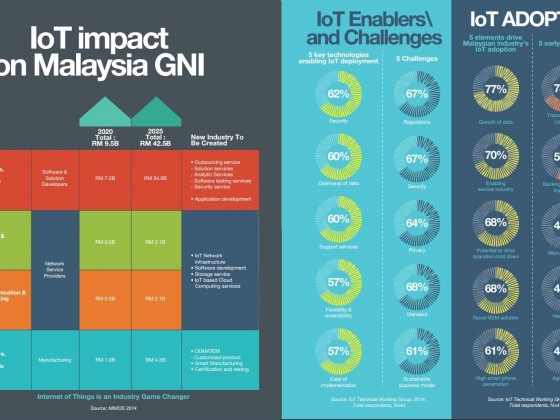by | myForesight®Analytics
Robots that were originally introduced to assume ‘dirty, dull, and dangerous’ jobs, have now been in commercial use for 50 years. The adoption and development of robotic technology is driven by the demand for increased economic productivity, the desire to improve quality of life, and the need of security forces and agencies.
Although robotics technology has developed tremendously in several other countries such as Germany, Great Britain, Japan, etc., USA is still recognised by many as the pioneer and considered as one of the most advanced in robotics field. Therefore, any attempt to trace or plan the roadmap of robotic technology, particularly for a developing nation like Malaysia, may have to look at the US Robotics Roadmap as referral.
What is US Robotics Roadmap, when and how was it developed, and what were the factors taken into consideration?
In 2009, the Computing Community Consortium and the Computing Research Association, spurred by technology developments enabling the application of robots beyond traditional manufacturing uses, sponsored a group of leading US academic robotics researchers to create a technology roadmap for robotics. In 2013, researchers from many of the same institutions, working with industry users and government program managers in a project sponsored by the Robotics Virtual Organization (VO), updated the roadmap. Five workshops were held. Each workshop focused on a different application area. The areas of examination were:
• Business and application drivers of robotics growth
• Technology gaps that must be filled to deliver solutions to robotics users
• Basic research required to fill those gaps
The output of the workshops offered a preferred future for robotics in each area. Three most important application areas are manufacturing, health and medicine, and service.In the capability roadmap, the report offered examples of possible five-, ten-, and fifteen-year milestones for each identified robotics capabilities.
Robotics for Manufacturing
Although manufacturing accounted for 14% of US GDP and 10% of employment, the US balance of trade in manufactured goods was dropping at the rate of $50 billion per decade. According to the Robotics VO roadmap, robotics has the potential to make US manufacturing more cost competitive and more flexible; create jobs and improve working conditions; and facilitate the repatriation of manufacturing activities.
Why robotics for manufacturing?
Both economic and technical needs are driving the growth of manufacturing robotics.
• Development of robotic manufacturing technology is essential to maintain the US global lead in worker productivity but Korea, the EU, and Japan each invest more than the US non-defence budget for robotics, manufacturing, and related research.
• Aging workforce: the ratio of workers to retirees will continue to fall, and the supply of workers will be increasingly limited. Robotics can make up for some of the gap in skilled employees by making employees more productive.
• Next-generation products with embedded computers and sensors will require microscale and nanoscale assembly that human workers cannot perform.
• Vignettes from the Robotics VO roadmap illustrate attractive use cases for manufacturing robotics.
– A robot-assisted auto assembly line could be rapidly reconfigured to accommodate model changes and changes in parts specifications.
– A robot working in a small-job shop with five human employees could quickly manufacture custom, one-of-a-kind medical devices — following instructions, operating tools and machines, cleaning up spills, and asking for assistance when instructions are unclear.
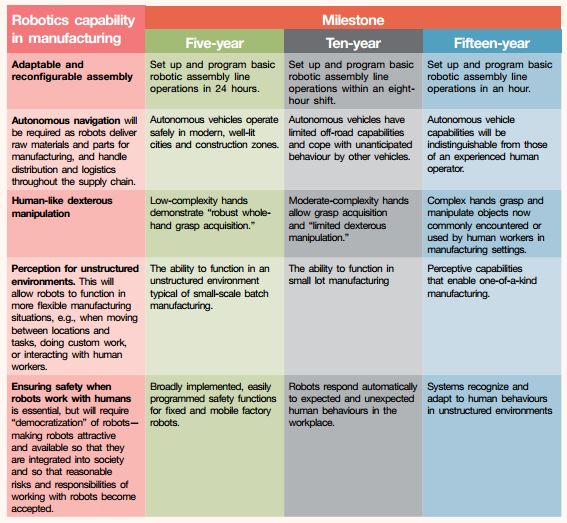
Capabilities roadmap
To fulfil its potential for manufacturing, robotics will require a variety of critical new capabilities.
The report also offered milestones for green manufacturing, model-based integration and design of supply chains, nano-manufacturing, and robotics training.
Robotics for Health and Medicine
The need for robotics in health and medicine is motivated broadly by three overarching factors: the need to improve access to healthcare, the need to improve outcomes, and the need to focus on prevention.
Why robotics for health and medicine?
Underlying drivers include aging population, the increase in chronic diseases, the need for personalized care (e.g., for stroke patients or those diagnosed with autism), and the increase in cases of lifelong dependency on healthcare. Improved healthcare could enable elderly and disabled individuals to contribute, or continue to contribute, to the workforce. Robotic technology has the potential to improve:
• Healthcare access, e.g., through the use of telemedicine to extend access to underserved or inaccessible sites.

• Healthcare affordability, offering better cost-benefit ratios and leading to improved productivity of the general workforce.
• Healthcare qualityincluding better risk-benefit ratios, less-invasive procedures, and fewer side effects.
The Robotics VO Roadmap suggested a variety of potential applications of robotics in health and medicine, some of which has been implemented:
• Surgery in which robots extend the physical capabilities of surgeons and execute preplanned procedures. For example, a surgeon could use a miniature robotic surgical instrument, along with imaging technology, to reach and remove cancerous tissue from an internal organ.
• Replacing lost function such as via intelligent orthotic and prosthetic devices. For example, a prosthetic arm and hand might offer control through a brainmachine interface and provide force, texture, and temperature feedback to a patient.
• Recovery and rehabilitation in which robotic systems provide sensory-motor therapy to stroke victims; this could include dynamic interactions such as personalized motivation and coaching based on real-time sensor data.
• Behavioural therapy provided by socially assistive robotics, e.g., supervision, coaching, and cognitive exercises to assist the growth and development of a child with an autism spectrum disorder.
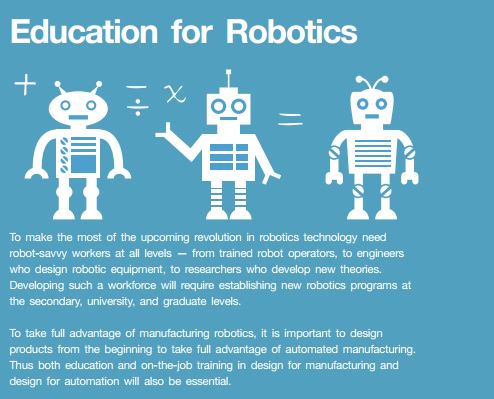
• Personalized care for the aged or other populations with special needs, e.g., promoting aging in place, offering companionship, and helping to delay the onset of dementia.
• Health and wellness promotion, in which robotics can play a role along with computers, wearable devices, and in-home sensors, e.g., to assist and motivate a diabetic user to exercise, eat properly, and conduct daily bloodglucose monitoring.
• Research, e.g., data-gathering or simulation of biological systems.
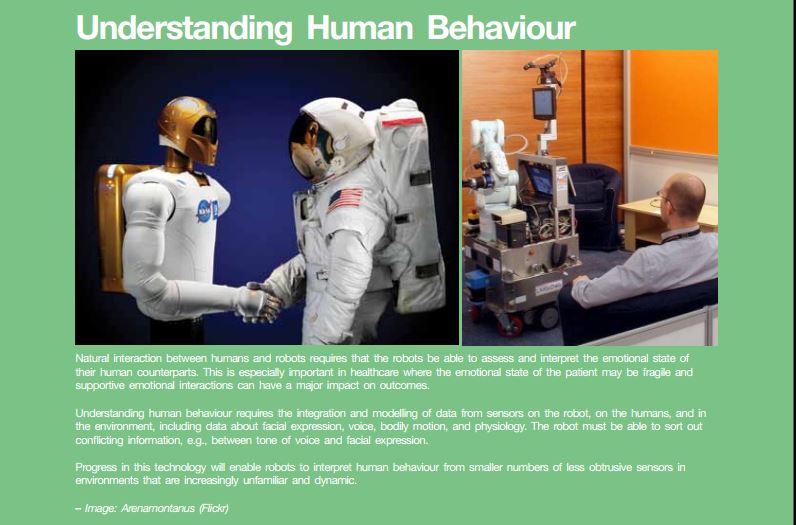
The Robotics VO report also provided milestones for robot-mediated health communication; automated understanding of human state and behaviour; quantitative assessment, diagnosis, and training; models of individual users; sensor-based, automated acquisition of health data; and robot safety.
Robotics for Service
Service robots assist people at work, at home, and at leisure. Professional service robotics support workplace tasks in “agriculture, emergency response, pipelines, the national infrastructure, forestry, transportation, professional cleaning, and various other disciplines.” There are currently more than 110,000 professional robots in service. In contrast, personal service robots help at home, offer leisure fun, or help individuals with physical or mental limitations. The largest categories are vacuum cleaners (more than 6 million iRobot Roombas sold) and leisure robots (more than 4 million sold). Despite early success, “applications and solutions incorporating full-scale, general autonomous functionality” are likely 10–15 years in the future, though more limited applications are ripe for current development.
Note that the service robotics category overlaps with both robotics for manufacturing and robotics in health and medicine.
Why robotics for service?
Aging is an important driver for the development of service robotics. Professional service robotics will effectively multiply the shrinking workforce in developed nations like Japan, supporting economic growth, while personal service robotics will enable and extend personal independence and function. In addition to healthcare and manufacturing, the most important markets for professional and personal service robotics will be:
• Workplace assistance beyond manufacturing. For example, in the field of agriculture, automated crop spraying and harvesting have been prototyped; Caterpillar is developing autonomous haul trucks for mining operations.
• Energy and the environment including automated energy exploration and automated environmental monitoring. For example, Shell has already begun using UAVs to assist in oil exploration in the Arctic.
• Automotive and transportation including driver assistance, automated public transit, autonomous personal and fleet vehicles, and smart highways.
• Homeland security and infrastructure protection including automated inspection and maintenance of bridges, pipelines, and other critical infrastructure; for example, robots are used to automatically inspect and image wastewater systems.
• Entertainment and education especially in inspiring students’ interest in science, technology, engineering, and mathematics.
It is interesting to note that service robotics represent a natural extension of the Internet from sensing at a distance to acting at a distance.
CAPABILITIES ROADMAP
Many new capabilities will be required for robotics to fulfil its potential in health and medicine.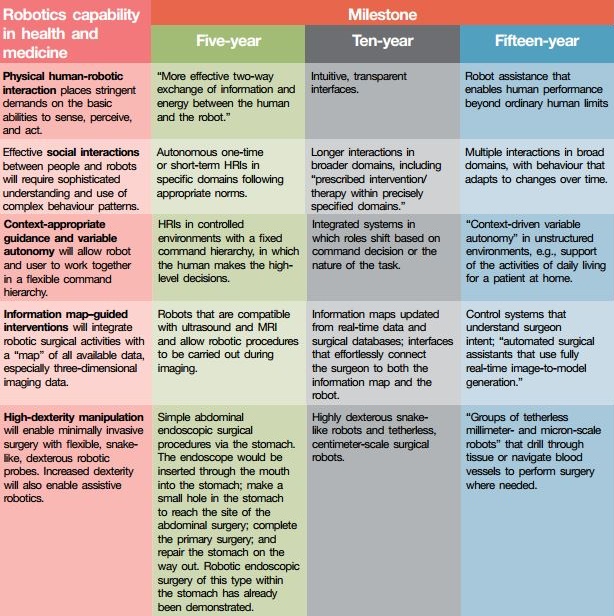
The Robotics VO report also provided milestones for robot-mediated health communication; automated understanding of human state and behaviour; quantitative assessment, diagnosis, and training; models of individual users; sensor-based, automated acquisition of health data;
and robot safety.
ROBOTICS FOR SERVICE
Service robots assist people at work, at home, and at leisure. Professional service robotics support workplace tasks in “agriculture, emergency response, pipelines, the national infrastructure, forestry, transportation, professional cleaning, and various other disciplines.” There are currently more than 110,000 professional robots in service. In contrast, personal service robots help at home, offer leisure fun, or help individuals with physical or mental limitations. The largest categories are vacuum cleaners (more than 6 million iRobot Roombas sold) and leisure robots (more than 4 million sold). Despite early success, “applications and
solutions incorporating full-scale, general autonomous functionality” are likely 10–15 years in the future, though more limited applications are ripe for current development.
Note that the service robotics category overlaps with both robotics for manufacturing and robotics in health and medicine.
Why robotics for service?
Aging is an important driver for the development of service robotics. Professional service robotics will effectively multiply the shrinking workforce in developed nations like Japan, supporting economic growth, while personal service robotics will enable and extend personal independence and function. In addition to healthcare and manufacturing, the most important markets for professional and personal service robotics will be:
• Workplace assistance beyond manufacturing. For example, in the field of agriculture, automated crop spraying and harvesting have been prototyped; Caterpillar is developing autonomous haul trucks for mining operations.
• Energy and the environment including automated energy exploration and automated environmental monitoring. For example, Shell has already begun using UAVs to assist in oil exploration in the Arctic.
• Automotive and transportation including driver assistance, automated public transit, autonomous personal and fleet vehicles, and smart highways.
• Homeland security and infrastructure protection including automated inspection and maintenance of bridges, pipelines, and other critical infrastructure; for example, robots are used to automatically inspect and image wastewater systems.
• Entertainment and education especially in inspiring students’ interest in science, technology, engineering, and mathematics.
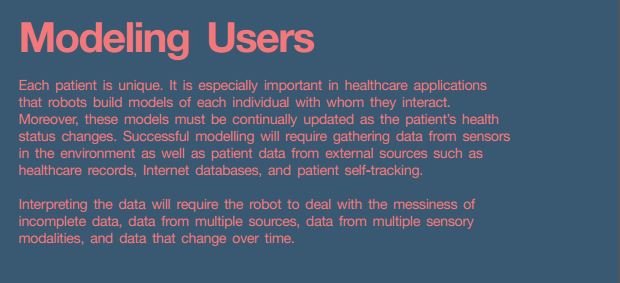 It is interesting to note that service robotics represent a natural extension of the Internet from sensing at a distance to acting at a distance.
It is interesting to note that service robotics represent a natural extension of the Internet from sensing at a distance to acting at a distance.

CAPABILITIES ROADMAP
If service robots are to meet their potentials in professional and personal settings, sophisticated new capabilities will need to be developed.
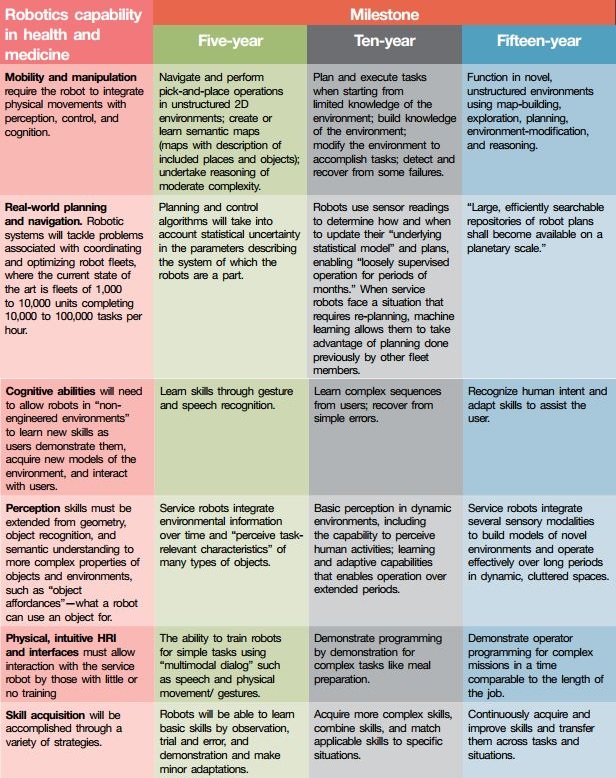
Apart from technological advances, successful utilisation of service robotics also requires appropriate government regulations, industry standards, independent certification processes, and consideration of liability issues.
BASIC RESEARCH PRIORITIES
While the three broad uses of robotics reviewed offer distinct sets of specific applications, it should be clear by now that there is considerable overlap among the lists of capabilities required to enable those applications. Developing those capabilities will require progress in a number of fields of basic research — fields that apply across manufacturing, health and medicine, and service robotics.
• Architecture and representations. Robot operating systems must integrate low-level perception-action functions with high-level cognition. They must also allow for representations of environments, skills, and people; for reasoning and learning; for social interaction; and for failure recovery. Until today, there is no universally accepted architectural framework for such systems.
• Control and planning. Issues including the control of physical contact and force for medical robots, control of systems with many degrees of freedom, and planning in dynamic and uncertain environments that include human interaction and sensor feedback.
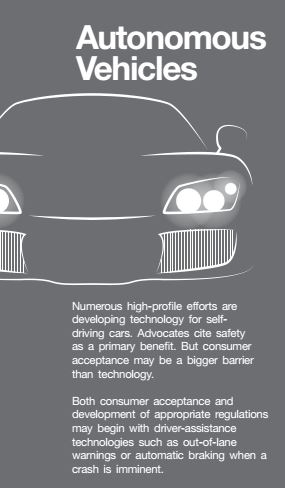
• Perception will be a key skill as robots must learn to operate in unfamiliar environments and with unfamiliar objects. Robots will also need to understand human perception in order to communicate effectively, and to perceive and understand human activity in real-time.
• Robust, high-fidelity sensors and measurement science. Important development fields include “bio-compatible/implantable sensors, force/tactile sensing, and sensors that allow tracking and navigation.” New sensors need to function well in difficult, changing environments, e.g., situations with low or variable light.
• Physical HRI. As robots interact directly and physically with humans, important design criteria should include safety and function that appears natural. For example, haptics technology should make the robot “transparent” to a user performing surgery remotely.
• Socially interactive robots. This area may present some of the most difficult technical challenges. Humans and robots must be able to understand and interpret one another’s behaviour and intent. This requires bidirectional interaction through verbal and nonverbal communication channels. A full span of social interaction is required if robots are to be adopted long-term. For example, healthcare robots must be able to “obtain the user’s trust and sustain the user’s interest.”
• Measurement science. Measurement methods, reference data, and standards are crucial to technical progress.
• Cloud robotics and automation for manufacturing. Cloud robotics makes use of cloud computing to assist robots by storing maps and images, performing complex modelling and planning, sharing information and experience between robots, and providing human guidance when requested.
BUSINESS IMPLICATIONS
• The clear trajectory is for robots to move from controlled, carefully engineered settings on factory floors toward less structured settings in which they will interact more often and more naturally with humans. Businesses of all kinds should begin to envision a future when robots will likely play a role in settings outside manufacturing and to consider what this will mean for their operations.
• The proliferation of robots in health, medicine, and service applications could create consumer backlash just as automated call-response systems have generated cries for the return of knowledgeable human customer service representatives. Businesses considering the application of robots in human-contact applications must carefully consider whether consumers are ready to accept them and what factors in robot design are most important in increasing consumer acceptance.
• Businesses that operate automated voice and online systems for customer interaction should consider whether developments in robot social-interaction technology could improve automated customer service.
• Robots that function on the microscale and nanoscale will make it possible to manufacture products that humans are unable to assemble. Manufacturers will have the opportunity to consider a broader range of designs when planning new products.
• When manufacturers acquire new production capacity, they will face difficult choices: They may be better served if they choose robotics over traditional infrastructure because robotics can be more flexibly repurposed for new products and become obsolete less rapidly. However, as robotic technology is rapidly developing, the robots themselves could be outpaced by new designs in relatively short order. Additionally, companies that “employ” robots will be open to criticism about displacing workers.
• The expansion of robotic applications in health, medicine, and service depends heavily on the development of new capabilities in human-robot interaction. Researchers and businesses with new discoveries and technologies to offer in this arena will find an eager audience.
• Robotics has the potential to deliver customization and personalization of goods through more flexible manufacturing and logistics, as well as to deliver professional services in healthcare and other arenas. Robotics could even provide consumer experiences — by understanding and adapting to the dynamic needs and situation of the people with whom the robot is interacting, e.g., by configuring an automobile interior or office space to meet the current needs of the occupants.
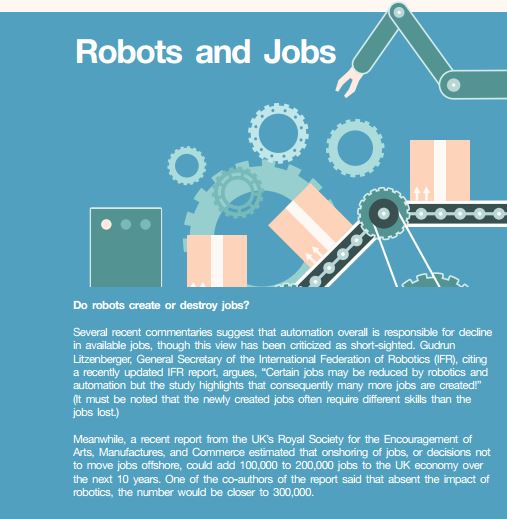
• As the use of robotics in healthcare has the potential to help control the growth of healthcare costs, demands for work in this area will likely increase.
• Sensing and perception technology that is being developed for robotics for manufacturing, health, and service applications (for example, the technology to understand human emotions and intentions) will also find application in public safety and national security. The use of this technology in any context will heighten privacy concerns which will shift from “who is watching me, and when?” to “what are the capabilities of those who are watching to infer about me?”
• In a recent keynote speech at an autonomous vehicles conference, Bryan Reimer of MIT “warned that the public is far less accepting of mechanical failure than human error.” This means that the bar for robot safety will be extremely high and suggests that even when robots operate more safely than human operators they replace, robot error could lead to substantial liability issues.
• Development of robotics requires successful basic research in a number of fundamental scientific arenas, including mathematics, information technology, sensors, perception, learning, and human behaviour. The potential for spin-offs into adjacent areas of technology is quite great. Therefore, companies working in adjacent spaces should monitor robotics progress carefully even if they have no plans to enter the field or make direct use of robots.
References
1. “From Internet to Robotics,” Computing Community Consortium, May 21, 2009, www. us-robotics.us.
2. “A Roadmap for US Robotics: From Internet toRobotics, 2013 Edition,” Robotics VO, March 20, 2013, http://robotics-vo.us.
3. Jason Dorrier, “DARPA’s Robotic Hand Can Unlock and Open Your Door,” Singularity Hub, May 17, 2013, http://singularityhub.com.
4. Jason Dorrier, “DARPA’s Robotic Hand Can Unlock and Open Your Door,” Singularity Hub, May 17, 2013, http://singularityhub.com.
5. “Plenary Lectures,” ICORR 2013, viewed July 2013, http://depts.washington.edu.
6. “Flexible Robotic Endoscopy Allows for Scarless Surgeries via Mouth,” medGadget, July 7, 2011, www.medgadget.com.
7. Spencer Ackerman, “Drone Boosters Say Farmers, Not Cops, Are the Biggest US Robot Market,” Wired, February 5, 2013, www.wired.com
8. “Images on Demand,” CropCam, viewed July 2013, www.cropcam.com.
9. “FIRST Robotics Competition,” FRC, viewed June 2013, www.usfirst.org.
10. David Szondy, “CHIBA Robotic Wheelchair Turns Wheels into Legs,” Gizmag, October 17, 2012, www.gizmag.com.
11. Jayne O’Donnell, “Self-Driving Cars Could Have a Long Road to Acceptance,” USA Today, June 14, 2013, www.usatoday.com.
12. Thomas Frey, “Fastest Way to Create New Jobs? Automate Them Out of Existence!” The Futurist, February 22, 2013, www.wfs.org; Steve Lohr, “More Jobs Predicted for Machines, Not People,” New York Times, October 23, 2011, www.nytimes.com.
13. Bill Lydon, “IFR: Robots Improve Manufacturing Success & Create Jobs,” International Federation of Robotics, February 28, 2013, www.ifr.org.
14. Mark Wembridge and Andrew Bounds, “UK Onshoring ‘Minimal and Restricted to Smaller Companies’,” Financial Times, June 2, 2013, www.ft.com.
15. Jayne O’Donnell, “Self-Driving Cars Could Have a Long Road to Acceptance,” USA Today, June 14, 2013, www.usatoday.com.


